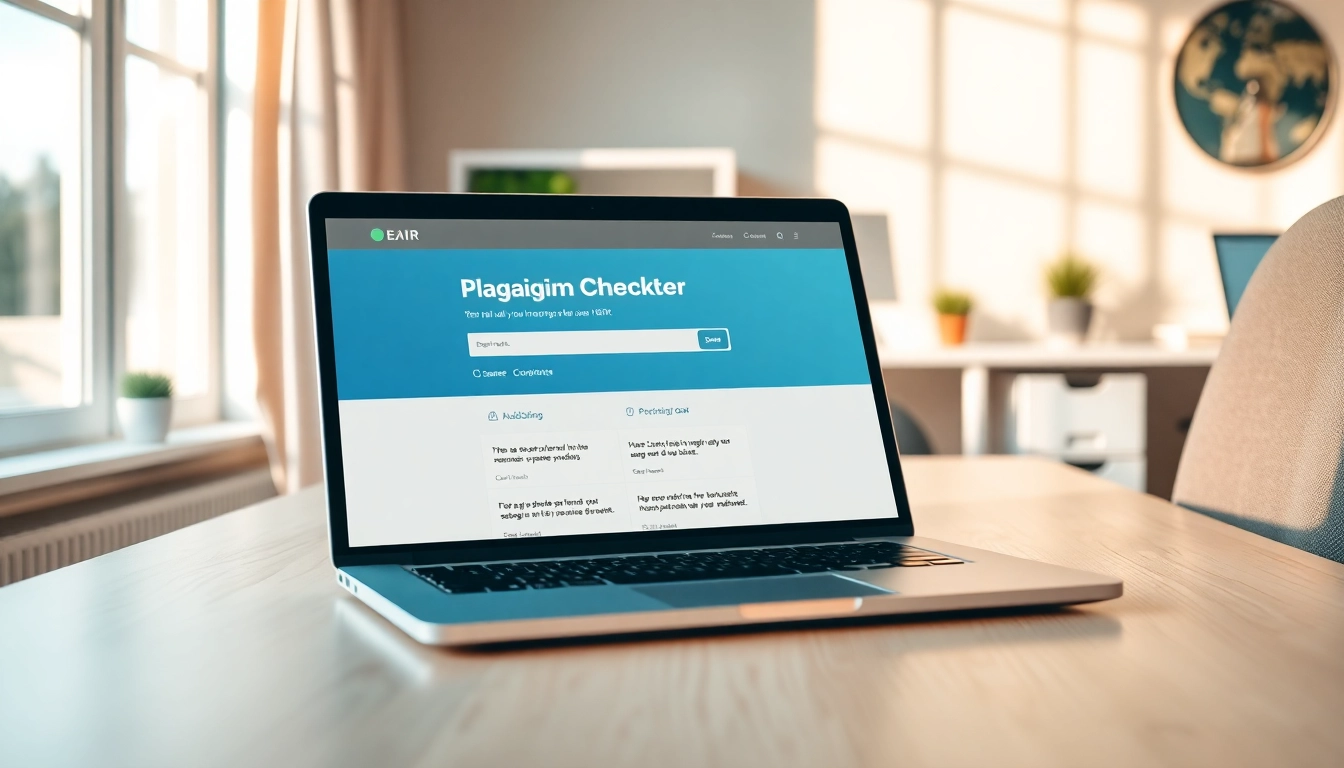Understanding the Need for a Plagiarism Checker
In an increasingly interconnected world, the ability to produce original content is not just a matter of academic integrity; it also carries significant implications for one’s professional reputation. A reliable plagiarism checker is essential for safeguarding this aspect of writing. Whether you are a student, educator, researcher, or content creator, there is a growing need to ensure that your work is original and free from unintentional plagiarism.
Why Plagiarism Matters in Academic and Professional Work
Plagiarism is not merely copying someone else’s words; it encompasses any form of intellectual theft, including paraphrasing without credit and using someone else’s ideas as your own. In academic settings, it undermines the value of education and can lead to severe penalties, including expulsion. In professional arenas, plagiarism can tarnish reputations, lead to job losses, and even incur legal consequences. Thus, understanding the stakes is crucial, as actions heavily influenced by unoriginal work can have far-reaching effects beyond immediate academic grades or professional success.
Common Misconceptions about Plagiarism Checkers
Many users possess misconceptions about how plagiarism checkers operate. Some believe that these tools catch every instance of plagiarism. However, limitations exist in their databases and algorithms. Others think that simply running a document through a checker guarantees its originality. Understanding these misconceptions helps users employ these tools more effectively, leveraging them as just one component of a broader strategy for maintaining academic and professional integrity.
How Plagiarism Checkers Work: A Technical Overview
Plagiarism checkers typically utilize text-matching algorithms to compare submitted documents against vast databases of existing content, which include academic works, online articles, and various publications. Some advanced checkers also employ semantic analysis to detect paraphrasing, while others utilize artificial intelligence to enhance matching capabilities. When analyzing a document, the checker produces a report that highlights potentially plagiarized areas, offering a percentage that indicates similarity. This technical foundation places modern plagiarism detection at the intersection of technology and ethics, making it a critical tool in the scholarly and professional landscape.
Choosing the Right Plagiarism Checker Tool
Key Features to Look for in a Plagiarism Checker
When selecting a plagiarism checker, several key features merit consideration:
- Database Size: Ensure that the checker can access a comprehensive database of sources, including academic journals and online publications.
- Speed: Examine the processing time required for the tool to analyze documents, particularly for lengthy papers.
- Accuracy: Look for both false positives and false negatives. Some tools may flag common phrases as plagiarism, which can skew results.
- User Interface: Choose a tool that offers an intuitive interface so that users can easily navigate the features it provides.
- Reporting Features: Consider options that provide detailed reports with identifiable sections of commonality and context about matched sources.
Comparing Free vs. Paid Plagiarism Checkers
One prevalent query is whether to opt for free or paid plagiarism checkers. Free tools offer basic functionalities but often fall short in database size and accuracy. Paid options typically include extensive databases, advanced algorithms, and more thorough reporting features. For professionals and students who depend on producing high-quality, original work, the investment in a paid tool may be worthwhile. Weighing your specific needs against the available choices can guide an informed decision.
User Experience: Reviews and Recommendations
User experience plays a crucial role in selecting a plagiarism checker, as usability can significantly alter how effectively you utilize these tools. Checking out reviews and recommendations from credible sources can provide insights into the reliability and functionality of various tools. Look for features like real-time scanning, customer support, and the ability to handle multiple file formats. Feedback from other users can often reveal potential drawbacks and advantages that may not be apparent from promotional material alone.
Best Practices for Using a Plagiarism Checker
How to Properly Analyze Plagiarism Reports
Upon receiving a plagiarism report, the first step is to review the highlighted sections critically. Understanding why certain passages were flagged is essential, as it allows you to identify unintentional plagiarism versus legitimate citations. Focus on the percentage similarity score; a lower score is typically indicative of primarily original content. Moreover, utilize the provided sources to help improve and appropriately cite your work.
Integrating Plagiarism Checkers into Your Workflow
To maximize the effectiveness of a plagiarism checker, integrate it into your writing workflow. Start by checking drafts during the writing process rather than waiting until the final product is complete. Regular checks can help catch unintentional plagiarism early, allowing for corrections before submission. This proactive approach fosters a habit of maintaining originality throughout the writing phase, rather than treating checks as a last-minute necessity.
Combining Manual Checks with Digital Tools
While digital checks are invaluable, combining them with manual scrutiny offers a more comprehensive approach to content integrity. By developing skills in citation, paraphrasing, and summarizing, you can reduce reliance on technology alone. Implement techniques such as reading aloud or summarizing your work independently to assess clarity and originality before utilizing a plagiarism checker. This dual-method strategy prepares you to engage both digitally and personally with your material.
Common Challenges with Plagiarism Checkers
Limitations of Plagiarism Checkers: What They Can’t Detect
Despite their advancements, plagiarism checkers have inherent limitations. They often struggle with detecting nuanced paraphrasing or sources that are not included in their databases. Moreover, some checkers may not effectively differentiate between common knowledge and unique ideas, leading to inaccuracies in reports. Understanding these limitations can help you use these tools more effectively while relying on your judgment to assess originality accurately.
Troubleshooting Common Issues with Plagiarism Checkers
Users may encounter various issues with plagiarism checkers ranging from upload problems to inaccurate reports. Ensure that your document format is compatible with the tool and contains no formatting issues that could obstruct analysis. When false positives appear, check the flagged content against the original source to determine whether it genuinely constitutes plagiarism. In cases of persistent trouble, contacting customer support can often resolve more technical matters efficiently.
Maintaining Academic Integrity: Strategies Beyond Tools
While plagiarism checkers serve a vital function, preventing plagiarism goes beyond merely running content through a digital tool. Adopt practices such as comprehensive note-taking, understanding citation styles, and creating original outlines to avoid temptation. Fostering a culture of academic integrity within educational and professional settings further enhances the importance of originality. Additionally, promoting collaborative discussions can also encourage new ideas while respecting intellectual property rights.
The Future of Plagiarism Detection Technologies
Emerging Trends in Plagiarism Detection
The landscape of plagiarism detection is evolving rapidly with technology’s advancement. New trends include the incorporation of artificial intelligence to enhance matching algorithms and contextual analysis, leading to more accurate detection of unintentional plagiarism. Furthermore, as more educational institutions adopt technology-driven approaches, the standards of acceptable originality continue to rise, prompting tool developers to innovate consistently.
The Role of Artificial Intelligence in Plagiarism Checkers
Artificial intelligence is revolutionizing plagiarism checkers by improving their ability to detect not just copied text, but also concept similarities and less typical forms of plagiarism. Through machine learning, these tools will continue to evolve in sophistication, recognizing patterns that human reviewers might overlook. The implications for educational institutions are substantial as AI-generated content becomes more prevalent, necessitating new methods of detection and evaluation.
Preparing for Changes in Plagiarism Detection Standards
As technological advancements reshape how we engage with content, it is imperative to stay informed about changes in plagiarism detection standards. Academic institutions may revise their policies to accommodate new types of content and writing practices, and staying abreast of these changes can facilitate better compliance. Continuous education on ethical writing practices will enhance both students’ and professionals’ abilities to navigate this evolving landscape with integrity.



